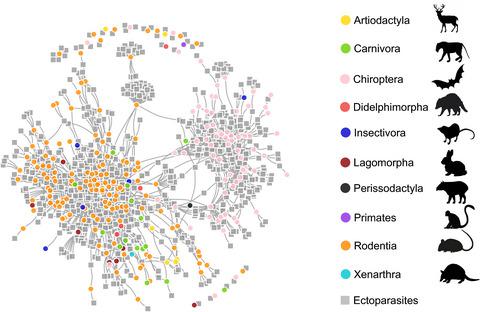当前位置:
X-MOL 学术
›
J. Anim. Ecol.
›
论文详情
Our official English website, www.x-mol.net, welcomes your
feedback! (Note: you will need to create a separate account there.)
Species-level drivers of mammalian ectoparasite faunas
Journal of Animal Ecology ( IF 3.5 ) Pub Date : 2020-04-04 , DOI: 10.1111/1365-2656.13216 Wesley Dáttilo 1 , Nathalia Barrozo-Chávez 2 , Andrés Lira-Noriega 3 , Roger Guevara 4 , Fabricio Villalobos 4 , Diego Santiago-Alarcon 5 , Frederico Siqueira Neves 6 , Thiago Izzo 7 , Sérvio Pontes Ribeiro 8
Journal of Animal Ecology ( IF 3.5 ) Pub Date : 2020-04-04 , DOI: 10.1111/1365-2656.13216 Wesley Dáttilo 1 , Nathalia Barrozo-Chávez 2 , Andrés Lira-Noriega 3 , Roger Guevara 4 , Fabricio Villalobos 4 , Diego Santiago-Alarcon 5 , Frederico Siqueira Neves 6 , Thiago Izzo 7 , Sérvio Pontes Ribeiro 8
Affiliation

|
Traditionally, most studies have described the organization of host-parasite interaction networks by considering only few host groups at limited geographical extents. However, host-parasite relationships are merged within different taxonomic groups and factors shaping these interactions likely differ between host and parasite groups, making group-level differences important to better understand the ecological and evolutionary dynamics of these interactive communities. Here we used a dataset of 629 ectoparasite species and 251 species of terrestrial mammals, comprising 10 orders distributed across the Nearctic and Neotropical regions of Mexico to assess the species-level drivers of mammalian ectoparasite faunas. Specifically, we evaluated whether body weight, geographic range size, and within-range mammal species richness (i.e., diversity field) predict mammal ectoparasite species richness (i.e., degree centrality) and their closeness centrality within the mammal-ectoparasite network. In addition, we also tested if the observed patterns differ among mammal orders and if taxonomic closely related host mammals could more likely share the same set of ectoparasites. We found that ectoparasite species richness of small mammals (mainly rodents) with large proportional range sizes was high compared to large-bodied mammals, whereas the diversity field of mammals had no predictive value (except for bats). We also observed that taxonomic proximity was a main determinant of the probability to share ectoparasite species. Specifically, the probability to share ectoparasites in congeneric species reached up to 90% and decreased exponentially as the taxonomic distance increased. Further, we also detected that some ectoparasites are generalists and capable to infect mammalian species across different orders and that rodents have a remarkable role in the network structure, being closely connected to many other taxa. Hence, because many rodent species have synanthropic habits they could act as undesired reservoirs of disease agents for humans and urban animals. Considering the reported worldwide phenomenon of the proliferation of rodents accompanying the demographic decrease or even local extinction of large-bodied mammal species, these organisms may already be an increasing health threat in many regions of the world.
中文翻译:

哺乳动物外寄生物区系的物种层面驱动因素
传统上,大多数研究通过仅考虑有限地理范围内的少数宿主群体来描述宿主-寄生虫相互作用网络的组织。然而,宿主-寄生虫关系合并在不同的分类群体中,并且影响这些相互作用的因素在宿主和寄生虫群体之间可能有所不同,这使得群体水平的差异对于更好地理解这些互动群落的生态和进化动态非常重要。在这里,我们使用了 629 种外寄生虫物种和 251 种陆生哺乳动物(包括分布在墨西哥近北极和新热带地区的 10 个目)的数据集来评估哺乳动物外寄生虫动物群的物种层面驱动因素。具体来说,我们评估了体重、地理范围大小和范围内哺乳动物物种丰富度(即多样性场)是否可以预测哺乳动物外寄生虫物种丰富度(即程度中心性)及其在哺乳动物-外寄生虫网络中的接近中心性。此外,我们还测试了哺乳动物目之间观察到的模式是否不同,以及分类学密切相关的宿主哺乳动物是否更有可能共享同一组外寄生虫。我们发现,与大型哺乳动物相比,比例范围较大的小型哺乳动物(主要是啮齿动物)的体外寄生虫物种丰富度较高,而哺乳动物的多样性场没有预测价值(蝙蝠除外)。我们还观察到,分类学邻近性是共享外寄生虫物种概率的主要决定因素。具体来说,同属物种共享体外寄生虫的概率高达 90%,并且随着分类距离的增加呈指数下降。 此外,我们还发现一些体外寄生虫是多面性的,能够感染不同目的的哺乳动物物种,并且啮齿动物在网络结构中发挥着显着的作用,与许多其他类群密切相关。因此,由于许多啮齿类动物具有共生习性,因此它们可能成为人类和城市动物不良的疾病病原体储存库。考虑到据报道的全球范围内啮齿类动物繁殖伴随大型哺乳动物物种数量减少甚至局部灭绝的现象,这些生物体可能已经成为世界许多地区日益严重的健康威胁。
更新日期:2020-04-04
中文翻译:

哺乳动物外寄生物区系的物种层面驱动因素
传统上,大多数研究通过仅考虑有限地理范围内的少数宿主群体来描述宿主-寄生虫相互作用网络的组织。然而,宿主-寄生虫关系合并在不同的分类群体中,并且影响这些相互作用的因素在宿主和寄生虫群体之间可能有所不同,这使得群体水平的差异对于更好地理解这些互动群落的生态和进化动态非常重要。在这里,我们使用了 629 种外寄生虫物种和 251 种陆生哺乳动物(包括分布在墨西哥近北极和新热带地区的 10 个目)的数据集来评估哺乳动物外寄生虫动物群的物种层面驱动因素。具体来说,我们评估了体重、地理范围大小和范围内哺乳动物物种丰富度(即多样性场)是否可以预测哺乳动物外寄生虫物种丰富度(即程度中心性)及其在哺乳动物-外寄生虫网络中的接近中心性。此外,我们还测试了哺乳动物目之间观察到的模式是否不同,以及分类学密切相关的宿主哺乳动物是否更有可能共享同一组外寄生虫。我们发现,与大型哺乳动物相比,比例范围较大的小型哺乳动物(主要是啮齿动物)的体外寄生虫物种丰富度较高,而哺乳动物的多样性场没有预测价值(蝙蝠除外)。我们还观察到,分类学邻近性是共享外寄生虫物种概率的主要决定因素。具体来说,同属物种共享体外寄生虫的概率高达 90%,并且随着分类距离的增加呈指数下降。 此外,我们还发现一些体外寄生虫是多面性的,能够感染不同目的的哺乳动物物种,并且啮齿动物在网络结构中发挥着显着的作用,与许多其他类群密切相关。因此,由于许多啮齿类动物具有共生习性,因此它们可能成为人类和城市动物不良的疾病病原体储存库。考虑到据报道的全球范围内啮齿类动物繁殖伴随大型哺乳动物物种数量减少甚至局部灭绝的现象,这些生物体可能已经成为世界许多地区日益严重的健康威胁。











































 京公网安备 11010802027423号
京公网安备 11010802027423号